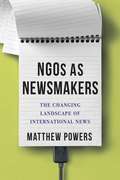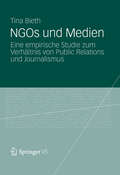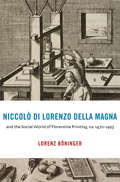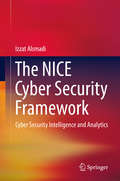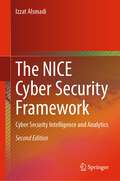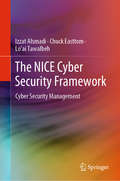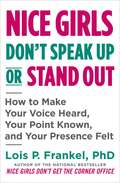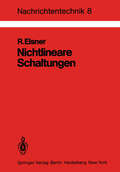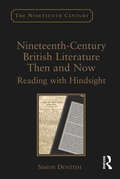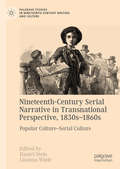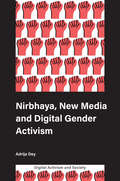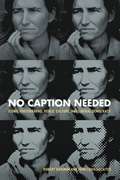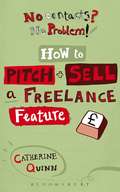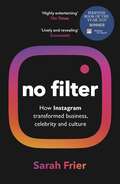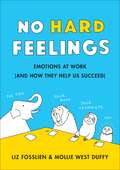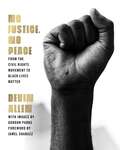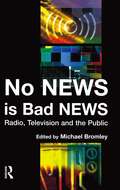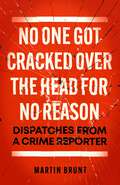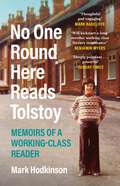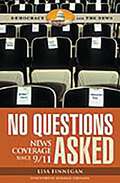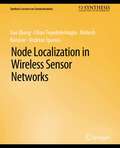- Table View
- List View
NGOs as Newsmakers: The Changing Landscape Of International News (Reuters Institute Global Journalism Ser. (PDF))
by Matthew PowersAs traditional news outlets' international coverage has waned, several prominent nongovernmental organizations have taken on a growing number of seemingly journalistic functions. Groups such as Amnesty International, Human Rights Watch, and M decins Sans Fronti res send reporters to gather information and provide analysis and assign photographers and videographers to boost the visibility of their work. Digital technologies and social media have increased the potential for NGOs to communicate directly with the public, bypassing traditional gatekeepers. But have these efforts changed and expanded traditional news practices and coverage--and are there consequences to blurring the lines between reporting and advocacy? In NGOs as Newsmakers, Matthew Powers analyzes the growing role NGOs play in shaping--and sometimes directly producing--international news. Drawing on interviews, observations, and content analysis, he charts the dramatic growth in NGO news-making efforts, examines whether these efforts increase the organizations' chances of garnering news coverage, and analyzes the effects of digital technologies on publicity strategies. Although the contemporary media environment offers NGOs greater opportunities to shape the news, Powers finds, it also subjects them to news-media norms. While advocacy groups can and do provide coverage of otherwise ignored places and topics, they are still dependent on traditional media and political elites and influenced by the expectations of donors, officials, journalists, and NGOs themselves. Through an unprecedented glimpse into NGOs' newsmaking efforts, Powers portrays the possibilities and limits of NGOs as newsmakers amid the transformations of international news, with important implications for the intersections of journalism and advocacy.
NGOs und Medien: Eine empirische Studie zum Verhältnis von Public Relations und Journalismus
by Tina BiethObwohl sich NGOs in den letzten Jahrzehnten enorm profiliert und gewandelt haben, sind sie kein prominenter Gegenstand der Kommunikationswissenschaft. Tina Bieth untersucht in ihrer empirischen Studie die Öffentlichkeitsarbeit dieser zivilgesellschaftlichen Akteure und ihre Beziehung zum Journalismus am Gegenstand von NGOs in der Entwicklungspolitik. Es geht um die Schnittstelle von NGO‐Forschung, PR-Forschung und Journalismusforschung. Während die Ressourcen für die entwicklungspolitische Berichterstattung der Presse tendenziell rückläufig sind, investieren die NGOs im Feld der Entwicklungspolitik angesichts schwieriger Umweltanforderungen verstärkt in ihre PR, so dass die Professionalisierung der Öffentlichkeitsarbeit einer Ökonomisierung des Journalismus gegenübersteht und die NGO-PR als eine Art Servicestelle der Redaktionen fungiert. Das Verhältnis von Public Relations und Journalismus wird daher wesentlich durch die Ressourcen für die entwicklungspolitische Berichterstattung und die Medienarbeit sowie die jeweiligen Ziele und den Stellenwert bestimmt.
Niccolò di Lorenzo della Magna and the Social World of Florentine Printing, ca. 1470–1493 (I Tatti studies in Italian renaissance history)
by Lorenz BöningerA new history of one of the foremost printers of the Renaissance explores how the Age of Print came to Italy. Lorenz Böninger offers a fresh history of the birth of print in Italy through the story of one of its most important figures, Niccolò di Lorenzo della Magna. After having worked for several years for a judicial court in Florence, Niccolò established his business there and published a number of influential books. Among these were Marsilio Ficino’s De christiana religione, Leon Battista Alberti’s De re aedificatoria, Cristoforo Landino’s commentaries on Dante’s Commedia, and Francesco Berlinghieri’s Septe giornate della geographia. Many of these books were printed in vernacular Italian. Despite his prominence, Niccolò has remained an enigma. A meticulous historical detective, Böninger pieces together the thorough portrait that scholars have been missing. In doing so, he illuminates not only Niccolò’s life but also the Italian printing revolution generally. Combining Renaissance studies’ traditional attention to bibliographic and textual concerns with a broader social and economic history of printing in Renaissance Italy, Böninger provides an unparalleled view of the business of printing in its earliest years. The story of Niccolò di Lorenzo furnishes a host of new insights into the legal issues that printers confronted, the working conditions in printshops, and the political forces that both encouraged and constrained the publication and dissemination of texts.
The NICE Cyber Security Framework: Cyber Security Intelligence and Analytics
by Izzat AlsmadiThis textbook is for courses in cyber security education that follow National Initiative for Cybersecurity Education (NICE) KSAs work roles and framework, that adopt the Competency-Based Education (CBE) method. The book follows the CBT (KSA) general framework, meaning each chapter contains three sections, knowledge and questions, and skills/labs for Skills and Abilities. The author makes an explicit balance between knowledge and skills material in information security, giving readers immediate applicable skills. The book is divided into seven parts: Securely Provision; Operate and Maintain; Oversee and Govern; Protect and Defend; Analysis; Operate and Collect; Investigate. All classroom materials (in the book an ancillary) adhere to the NICE framework.Mirrors classes set up by the National Initiative for Cybersecurity Education (NICE) Adopts the Competency-Based Education (CBE) method of teaching, used by universities, corporations, and in government trainingIncludes content and ancillaries that provide skill-based instruction on compliance laws, information security standards, risk response and recovery, and more
The NICE Cyber Security Framework: Cyber Security Intelligence and Analytics
by Izzat AlsmadiThis updated textbook is for courses in cyber security education that follow the National Initiative for Cybersecurity Education (NICE) framework which adopts the Competency- Based Education (CBE) method. The book creates content based on the Knowledge, Skills and Abilities (a.k.a. KSAs) described in the NICE framework. This book focuses on cyber analytics and intelligence areas. The book has 18 chapters: Introduction, Acquisition Management, Continuity Planning and Disaster Recovery, Cyber Defense Analysis and Support, Cyber Intelligence, Cyber Intelligence Analysis, Cyber Operational Planning, Cyber Policy and Strategy Management, Cyber Threat Analysis, Cybersecurity Management, Forensics Analysis, Identity Management, Incident Response, Collection Operations, Computer Network Defense, Data Analysis, Threat Analysis and last chapter, Vulnerability Assessment.
The NICE Cyber Security Framework: Cyber Security Management
by Izzat Alsmadi Chuck Easttom Lo’ai TawalbehThis textbook covers security controls and management. It is for courses in cyber security education that follow National Initiative for Cybersecurity Education (NICE) work roles and framework that adopt the Competency-Based Education (CBE) method. The book follows the CBE general framework, meaning each chapter contains three sections, knowledge and questions, and skills/labs for skills and sbilities. The author makes an explicit balance between knowledge and skills material in information security, giving readers immediate applicable skills. The book is divided into several parts, including: Information Assurance / Encryption; Information Systems Security Management; Information Systems / Network Security; Information Technology Management; IT Management; and IT Risk Management.
Nice Girls Don't Speak Up or Stand Out: How to Make Your Voice Heard, Your Point Known, and Your Presence Felt
by Lois P. FrankelDiscover the "must-listen for every smart, capable woman who wants to succeed"-a guide on how to communicate with maximum impact in the workplace that's the new book in the New York Times bestselling Nice Girls Don't series (Anne Fisher, Fortune.com). How many times have you asked yourself why you didn't speak up in a meeting? Or pushed for the raise you deserved? Or agreed to take on someone else's task because you didn't want to rock the boat? Whether the answer is once or ten times or more, the reason is the same: It's because you're a nice girl who goes along to get along. But staying quiet and being ignored are not paths to achievement.Now, in Nice Girls Don't Speak Up or Stand Out, Dr. Lois Frankel shows you how to be an effective communicator and advocate for yourself. From the basics of speaking up to navigating sticky situations and mastering the art of influencing others, this audiobook provides step-by-step advice using real-life examples and powerful tools such as:Be a broken recordChoose powerful wordNever say noEnlist advocatesAnd many more -- in bonus materials for extra tools in your pocketDr. Frankel chose the format of this new audio-first work carefully, with the mission of creating an interactive and impactful listen, interweaved with actionable recommendations, real-life anecdotes, and concrete examples of not only what to say in various scenarios, but how to say it. Nice Girls Don't Speak Up or Stand Out dives deeply into nearly one hundred everyday challenges women face related to communication.With Dr. Lois Frankel as your guide, you can learn how to express yourself confidently, courageously, and clearly -- and start taking charge of your career.
Nichtlineare Schaltungen: Grundlagen, Berechnungsmethoden, Anwendungen (Nachrichtentechnik #8)
by R. ElsnerNineteenth-Century British Literature Then and Now: Reading with Hindsight (The Nineteenth Century Series)
by Simon DentithEnvisioning today’s readers as poised between an impossible attempt to read texts as their original readers experienced them and an awareness of our own temporal moment, Simon Dentith complicates traditional prejudices against hindsight to approach issues of interpretation and historicity in nineteenth-century literature. Suggesting that the characteristic aesthetic attitude encouraged by the backward look is one of irony rather than remorse or regret, he examines works by Charles Dickens, George Eliot, Anthony Trollope, William Morris and John Ruskin in terms of their participation in significant histories that extend to this day. Liberalism, class, gender, political representation and notions of progress, utopianism and ecological concern as currently understood can be traced back to the nineteenth century. Just as today’s critics strive to respect the authenticity of nineteenth-century writers and readers who responded to these ideas within their historical world, so, too, do those nineteenth-century imaginings persist to challenge the assumptions of the present. It is therefore possible, Dentith argues, to conceive of the act of reading historical literature with an awareness of the historical context and of the difference between the past and the present while allowing that friction or difference to be part of how we think about a text and how it communicates. His book summons us to consider how words travel to the reality of the reader’s own time and how engagement with nineteenth-century writers’ anticipation of the judgements of future generations reveal hindsight’s capacity to transform our understanding of the past in the light of subsequent knowledge.
Nineteenth-Century British Literature Then and Now: Reading with Hindsight (The Nineteenth Century Series)
by Simon DentithEnvisioning today’s readers as poised between an impossible attempt to read texts as their original readers experienced them and an awareness of our own temporal moment, Simon Dentith complicates traditional prejudices against hindsight to approach issues of interpretation and historicity in nineteenth-century literature. Suggesting that the characteristic aesthetic attitude encouraged by the backward look is one of irony rather than remorse or regret, he examines works by Charles Dickens, George Eliot, Anthony Trollope, William Morris and John Ruskin in terms of their participation in significant histories that extend to this day. Liberalism, class, gender, political representation and notions of progress, utopianism and ecological concern as currently understood can be traced back to the nineteenth century. Just as today’s critics strive to respect the authenticity of nineteenth-century writers and readers who responded to these ideas within their historical world, so, too, do those nineteenth-century imaginings persist to challenge the assumptions of the present. It is therefore possible, Dentith argues, to conceive of the act of reading historical literature with an awareness of the historical context and of the difference between the past and the present while allowing that friction or difference to be part of how we think about a text and how it communicates. His book summons us to consider how words travel to the reality of the reader’s own time and how engagement with nineteenth-century writers’ anticipation of the judgements of future generations reveal hindsight’s capacity to transform our understanding of the past in the light of subsequent knowledge.
Nineteenth-Century Serial Narrative in Transnational Perspective, 1830s−1860s: Popular Culture—Serial Culture (Palgrave Studies in Nineteenth-Century Writing and Culture)
by Daniel Stein Lisanna WieleThis volume examines the emergence of modern popular culture between the 1830s and the 1860s, when popular storytelling meant serial storytelling and when new printing techniques and an expanding infrastructure brought serial entertainment to the masses. Analyzing fiction and non-fiction narratives from the United States, France, Great Britain, Germany, Austria, Turkey, and Brazil, Popular Culture—Serial Culture offers a transnational perspective on border-crossing serial genres from the roman feuilleton and the city mystery novel to abolitionist gift books and world’s fairs.
Nirbhaya, New Media and Digital Gender Activism (Digital Activism and Society: Politics, Economy and Culture in Network Communication)
by Adrija DeyThis title centres around digital gender activism focusing on the implications that the phenomenon of online gender activism has for politics, society, culture and gender relations/dynamics. On December 16th, 2012, Jyoti Singh, a female psychotherapy student from New Delhi was raped by six men in a moving bus while making her way home with a male friend. After 13 days spent fighting for her life, Jyoti Singh passed away. Abiding by Indian laws, Joyti’s actual name was never mentioned by the media and pseudonyms like ‘Nirbhaya’ (Hindi for fearless) were most commonly used. The brutal attack instantly triggered domestic and global criticism and widespread protests across India over the high levels of violence against Indian women and children, making it one of the biggest gender movements that the country has witnessed. The Nirbhaya case thus became a turning point in the politics of gender justice in India. The Nationwide protests that followed the case also witnessed one of the first and most extensive uses of digital technologies for activism in India having far reaching changes in how gender activism is conducted. Keeping the Nibhaya case at its core, this book explores and attempts to understand experiences and social constructs and investigate the use of digital technologies and social media by civil society actors, activists and organisations specifically for gender activism in India.
Nirbhaya, New Media and Digital Gender Activism: \ (Digital Activism and Society: Politics, Economy and Culture in Network Communication)
by Adrija DeyThis title centres around digital gender activism focusing on the implications that the phenomenon of online gender activism has for politics, society, culture and gender relations/dynamics. On December 16th, 2012, Jyoti Singh, a female psychotherapy student from New Delhi was raped by six men in a moving bus while making her way home with a male friend. After 13 days spent fighting for her life, Jyoti Singh passed away. Abiding by Indian laws, Joyti’s actual name was never mentioned by the media and pseudonyms like ‘Nirbhaya’ (Hindi for fearless) were most commonly used. The brutal attack instantly triggered domestic and global criticism and widespread protests across India over the high levels of violence against Indian women and children, making it one of the biggest gender movements that the country has witnessed. The Nirbhaya case thus became a turning point in the politics of gender justice in India. The Nationwide protests that followed the case also witnessed one of the first and most extensive uses of digital technologies for activism in India having far reaching changes in how gender activism is conducted. Keeping the Nibhaya case at its core, this book explores and attempts to understand experiences and social constructs and investigate the use of digital technologies and social media by civil society actors, activists and organisations specifically for gender activism in India.
No Caption Needed: Iconic Photographs, Public Culture, and Liberal Democracy
by Robert Hariman John Louis LucaitesIn No Caption Needed, Robert Hariman and John Louis Lucaites provide the definitive study of the iconic photograph as a dynamic form of public art. Their critical analyses of nine individual icons explore the photographs themselves and their subsequent circulation through an astonishing array of media, including stamps, posters, billboards, editorial cartoons, TV shows, Web pages, tattoos, and more. Iconic images are revealed as models of visual eloquence, signposts for collective memory, means of persuasion across the political spectrum, and a crucial resource for critical reflection. Arguing against the conventional belief that visual images short-circuit rational deliberation and radical critique, Hariman and Lucaites make a bold case for the value of visual imagery in a liberal-democratic society. No Caption Needed is a compelling demonstration of photojournalism’s vital contribution to public life.
No contacts? No problem! How to Pitch and Sell a Freelance Feature
by Catherine QuinnThere are plenty of books on the market which tell you how to write stylish prose, attention-grabbing headlines or market yourself better as a freelance writer. But how do you get that first piece published in a national publication? This book shows you the techniques that real freelancers use to sell their ideas and get into print.Professional freelancer Catherine Quinn, who built a successful freelance career from scratch, guides you through a step-by-step process to get your first article in print, from how to format your pitch, to identifying the undersold freelance hotspots.Her tried and tested step-by-step approach:- Shows you how to scope the market and pick the most likely potential customers- Gives the inside track on how to convince editors who've never heard of you to commission your work- Tells you what to expect at every step along the pitching process- Includes a four week plan with a day-by-day process to kick start your freelance career
No contacts? No problem! How to Pitch and Sell a Freelance Feature: How To Pitch And Sell A Freelance Feature
by Catherine QuinnThere are plenty of books on the market which tell you how to write stylish prose, attention-grabbing headlines or market yourself better as a freelance writer. But how do you get that first piece published in a national publication? This book shows you the techniques that real freelancers use to sell their ideas and get into print.Professional freelancer Catherine Quinn, who built a successful freelance career from scratch, guides you through a step-by-step process to get your first article in print, from how to format your pitch, to identifying the undersold freelance hotspots.Her tried and tested step-by-step approach:- Shows you how to scope the market and pick the most likely potential customers- Gives the inside track on how to convince editors who've never heard of you to commission your work- Tells you what to expect at every step along the pitching process- Includes a four week plan with a day-by-day process to kick start your freelance career
No Filter: The inside story of how Instagram transformed business, celebrity and our culture
by Sarah Frier‘Deeply researched and highly entertaining.’ The Times‘Vivid reporting and electric story-telling.’ Ashlee Vance, author of Elon Musk‘Clear-eyed and objective.’ New York Times The extraordinary inside story of how Instagram became the world’s most successful appIn just ten years, Instagram has gone from being a simple photo app to a $100-billion company. The journey has involved ground-breaking innovations, a billion-dollar takeover, and clashes between some of the biggest names in tech. But it’s a story that has never been told – until now. In No Filter, Bloomberg’s Sarah Frier reveals how Instagram became the hottest app in a generation, reshaping our culture and economy in the process. With astonishing access to all the key players – from Instagram’s co-founders to super-influencers like Kris Jenner – Frier offers behind-the-scenes glimpses of every moment in the company’s life: from its launch, to its unlikely acquisition by Facebook, to its founders’ dramatic disputes with their new boss, Mark Zuckerberg. But this is not just a Silicon Valley story. No Filter explores how Instagram has reshaped global business, creating a new economy of ‘influencers’ and pioneering a business model that sells an aspirational lifestyle to all of us. And it delves into Instagram’s effects on popular culture, rewiring our understanding of celebrity and placing mounting pressure on all of us to perform online – to the point of warping our perception of reality.The resulting book connects one company’s rise to a global revolution in technology, culture and business. Facebook’s decision to buy Instagram was the best investment it ever made. But we’re still learning about what it has cost the rest of us.
No Hard Feelings: Emotions at Work and How They Help Us Succeed
by Liz Fosslien Mollie West DuffyHave you ever worried about showing emotion at work, or panicked you've revealed too much of your personality?In No Hard Feelings, you'll learn how to navigate the emotional minefield that is the modern workplace, and express your feelings and identity at work. After all, the financial success of the 21st century depends on it. Without the ability to communicate and correct stress, we risk burnout. Without emotions, we cannot make decisions, influence others, or be creative. As our jobs become more collaborative, complex, and stressful - as well as the centre of our identities - effectively embracing emotion will only become more important. Combining behavioural economics and psychology with sharp, funny and colourful illustrations, No Hard Feelings shows readers how to be more authentic, productive, and happy at work. Liz Fosslien is a marketing and design consultant who illustrates the webcomic Out of the Office, and her work has been featured by the Economist, the Freakonomics blog, and NPR. Mollie West Duffy is an organizational designer at IDEO and a professor at Stanford University where she teaches design. She writes a blog and advises companies on start-up culture.
No Justice, No Peace: From the Civil Rights Movement to Black Lives Matter
by Devin AllenNautilus Book Awards' Better Books for a Better WorldA Movement in Words and Images Award-winning photographer Devin Allen has devoted the last six years to documenting the protests of the Black Lives Matter movement, from its early days in Baltimore, Maryland, up to the present day. The riveting images in No Justice, No Peace provide a lens on the resistance that has empowered Black lives generation after generation. Allen&’s signature black-and-white photos bear witness to the profound history of African Americans and allies in the fight for social justice and portray the collective action over decades in stunning, timeless portraits. Allen&’s remarkable photos of today&’s Black Lives Matter protests, which have been featured in the New York Times, the Washington Post, and twice on the cover of Time magazine, were inspired by Gordon Parks of the Civil Rights Movement, and create a vision of the past and future of Black activism and leadership in America. With contributions from twenty-six bestselling and influential writers and activists of today such as Clint Smith, DeRay Mckesson, D. Watkins, Jacqueline Woodson, Emmanuel Acho, Keeanga-Yamahtta Taylor, and more, alongside the words of past writers and activists such as Martin Luther King Jr, Frederick Douglass, Malcolm X, Maya Angelou, and John Lewis, No Justice, No Peace is a reminder of the moral responsibility of Americans to break unjust laws and take direct action. In words and pictures, No Justice, No Peace honors the connection between activism today and that of the past. If indeed hindsight is 20/20, this artistic look back is a lens on history that enlarges our understanding of the lasting predicament of racism in the United States of America. At once deeply intimate and profoundly uplifting, No Justice, No Peace is a visual tribute to Black resistance and a stern missive on the tough, but necessary, road that lies ahead.
No News is Bad News: Radio, Television and the Public
by Michael BromleyThis volume of collected essays provides a wide-ranging survey of the state of radio and television, especially the idea of public service broadcasting, and of news, current affairs and documentary programming in America, Australia, the UK and the rest of western Europe. Among the key issues it addresses are the 'dumbing down' of TV news, the infotainment factor in current affairs shows and the disappearance of the documentary. Using contemporary cases and examples - from the row over the scheduling of News at Ten in the UK to the creation of ABC News Online in Australia -- the essays link the performance of radio and television at the turn of the millennium with the processes of deregulation, liberalisation and digitalisation which have been evident since the 1980s. Working from a much needed and original comparative approach which encompasses complex and well-established public broadcasting in the USA as well as emerging and vulnerable participatory radio stations in El Salvador, the book sets a variety of experiences of factual radio and television programming within wider political and cultural contexts. It offers analyses of not only the 'problems' associated with news, current affairs and documentary broadcasting in an era of a declining public service ethos and the apparent triumph of the market, however. The essays also explore the potential of alternative radio and television, new forms of communication, such as the internet, and changing practices among journalists and programme makers, as well as the resilience of public broadcasting and the powers of the public to ensure that the media remain relevant and accountable. A companion text to the bestselling Sex, Lies and Democracy: The Press and the Public, this volume presents a multi-faceted approach to the tumultuous present and the uncertain future of news, current affairs and documentary in radio and television.
No News is Bad News: Radio, Television and the Public
by Michael BromleyThis volume of collected essays provides a wide-ranging survey of the state of radio and television, especially the idea of public service broadcasting, and of news, current affairs and documentary programming in America, Australia, the UK and the rest of western Europe. Among the key issues it addresses are the 'dumbing down' of TV news, the infotainment factor in current affairs shows and the disappearance of the documentary. Using contemporary cases and examples - from the row over the scheduling of News at Ten in the UK to the creation of ABC News Online in Australia -- the essays link the performance of radio and television at the turn of the millennium with the processes of deregulation, liberalisation and digitalisation which have been evident since the 1980s. Working from a much needed and original comparative approach which encompasses complex and well-established public broadcasting in the USA as well as emerging and vulnerable participatory radio stations in El Salvador, the book sets a variety of experiences of factual radio and television programming within wider political and cultural contexts. It offers analyses of not only the 'problems' associated with news, current affairs and documentary broadcasting in an era of a declining public service ethos and the apparent triumph of the market, however. The essays also explore the potential of alternative radio and television, new forms of communication, such as the internet, and changing practices among journalists and programme makers, as well as the resilience of public broadcasting and the powers of the public to ensure that the media remain relevant and accountable. A companion text to the bestselling Sex, Lies and Democracy: The Press and the Public, this volume presents a multi-faceted approach to the tumultuous present and the uncertain future of news, current affairs and documentary in radio and television.
No One Got Cracked Over the Head for No Reason: Dispatches from a Crime Reporter
by Martin Brunt“A cracking tale” – Duncan Campbell, investigative journalist and author of Underworld “A revelation” – Professor Sue Black, author of All That Remains and Written in Bone “Required reading for professional and amateur criminologists” – Gerald Seymour, bestselling author of Harry’s Game “Highly recommended” – Howard Sounes, author of Fred & Rose “A gripping read” – Patricia Wiltshire, author of Traces: The memoir of a forensic scientist and criminal investigator “This book is a must-read” – David Wilson, Professor Emeritus of Criminology *** What is it about crime that we find so fascinating, even if at the same time the details are repugnant? Why exactly do we immerse ourselves in true crime podcasts and TV shows? Has this appetite for gore shifted over the years? And what role does the crime reporter play in all of this? In this compelling book, Martin Brunt draws on the most shocking and harrowing stories he’s covered over the past thirty years to document the life of a crime reporter and assess the public obsession with crime that his reporting caters for. He also considers the wider relationship between the press and the police, the impact of social media and the question of why some crimes are ignored while others grip the nation. Featuring many undisclosed details on some of the biggest cases Brunt has covered, from the ‘Diamond Wheezers’ to Fred and Rose West, this blend of storytelling and analysis is not only a riveting overview of the nature of crime reporting but a reflection on the purpose of the profession in the first place.
No One Round Here Reads Tolstoy: Memoirs of a Working-Class Reader
by Mark HodkinsonMark Hodkinson grew up among the terrace houses of Rochdale in a house with just one book. His dad kept it on top of a wardrobe with other items of great worth – wedding photographs and Mark’s National Cycling Proficiency certificate. If Mark wanted to read it, he was warned not to crease the pages or slam shut the covers. Today, Mark is an author, journalist and publisher. He still lives in Rochdale, but is now snugly ensconced (or is that buried?) in a ‘book cave’ surrounded by 3,500 titles – at the last count. No One Round Here Reads Tolstoy is his story of growing up a working-class lad during the 1970s and 1980s. It’s about schools (bad), music (good) and the people (some mad, a few sane), and pre-eminently and profoundly the books and authors (some bad, mostly good) that led the way, and shaped his life. It’s also about a family who just didn’t see the point of reading, and a troubled grandad who, in his own way, taught Mark the power of stories. In recounting his own life-long love affair with books, Mark also tells the story of how writing and reading has changed over the last five decades, starting with the wave of working-class writers in the 1950s and 60s, where he saw himself reflected in books for the first time.
No Questions Asked: News Coverage since 9/11 (Democracy and the News)
by Lisa FinneganNo Questions Asked takes an overarching view of media coverage from the day of the 9/11 attacks through the war in Iraq. It also compares and contrasts how the U.S. media vs. international media covered key events during this period. Fact-based rather than polemical, the book explains why journalists responded the way they did during wartime and explores the ramifications for democracy of a weak press.The Fourth Estate's most important job is to present unbiased, accurate information about events, issues, and policies to the public. Without public scrutiny, administrations can become a breeding ground for bad and dangerous ideas.In recent years, for several reasons—including the brilliant psychological manipulation of the nation after the September 11, 2001, attacks—the American media have allowed administration officials to present information to the public without having to worry much about answering uncomfortable questions or having their policies deconstructed for public consumption. Relevant information is buried deep inside newspapers, and gaping holes can be found in many stories; in short, obvious and important questions remain unasked.The lack of questions from reporters led to a misunderstanding of the facts by the American public and, consequently, to their support of policies based on misinformation. Polls have revealed that more than half of Americans believe mistruths about the war in Iraq and world terrorism. Many, including members of the media, say the press has failed to do its job. Very few news reports filled in the basic blanks—the who, what, where, when, and whys—about U.S. foreign policy, the USA Patriot Act, the administration's insistence on the need for secrecy and more power, the truth about weapons of mass destruction in Iraq, and the necessity of sending our soldiers to topple another country's dictator, throwing an already tenuous region into dangerous imbalance. Very few reports are filling in those blanks now.
Node Localization in Wireless Sensor Networks (Synthesis Lectures on Communications)
by Xue Zhang Cihan Tepedelenlioglu Mahesh Banavar Andreas SpaniasIn sensor network applications, measured data are often meaningful only when the location is accurately known. In this booklet, we study research problems associated with node localization in wireless sensor networks. We describe sensor network localization problems in terms of a detection and estimation framework and we emphasize specifically a cooperative process where sensors with known locations are used to localize nodes at unknown locations. In this class of problems, even if the location of a node is known, the wireless links and transmission modalities between two nodes may be unknown. In this case, sensor nodes are used to detect the location and estimate pertinent data transmission activities between nodes. In addition to the broader problem of sensor localization, this booklet studies also specific localization measurements such as time of arrival (TOA), received signal strength (RSS), and direction of arrival (DOA). The sequential localization algorithm, which uses a subset of sensor nodes to estimate nearby sensor nodes' locations is discussed in detail. Extensive bibliography is given for those readers who want to delve further into specific topics.
